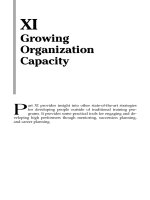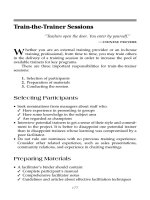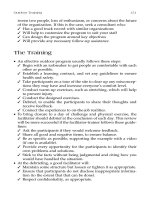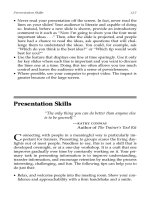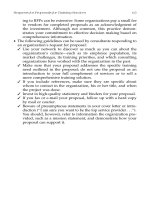The Trainer’s Tool Kit Second Edition phần 4 ppt
Bạn đang xem bản rút gọn của tài liệu. Xem và tải ngay bản đầy đủ của tài liệu tại đây (333.23 KB, 19 trang )
63Requests for Proposals for Training Services
ing to RFPs can be extensive. Some organizations pay a small fee
to vendors for completed proposals as an acknowledgment of
the investment. Although not common, this practice demon-
strates your commitment to effective decision making based on
comprehensive information.
• The following guidelines can be used by consultants responding to
an organization’s request for proposal:
✓ Use your network to discover as much as you can about the
organization’s culture—such as its employee population, its
market challenges, its training priorities, and which consulting
organizations have worked with the organization in the past.
✓ Make sure that your proposal addresses the specific training
need outlined in the proposal; do not use the proposal as an
introduction to your full complement of services or to sell a
more comprehensive training solution.
✓ If you include references, make sure they are specific about
whom to contact in the organization, his or her title, and when
the project was done.
✓ Invest in high-quality stationery and binders for your proposal.
✓ If you fax or e-mail your proposal, follow up with a hard copy
by mail or courier.
✓ Beware of presumptuous statements in your cover letter or intro-
duction (‘‘Iamsureyouwanttobethetopserviceprovider ’’).
You should, however, refer to information the organization pro-
vided, such as a mission statement, and demonstrate how your
proposal can support it.
PAGE 63
10916$ $CH3 10-21-04 08:00:34 PS
This page intentionally left blank
IV
Developing Training
Programs
F
or any training program to be successful, it needs to be en-
gaging, entertaining, and practical. Learners grasp concepts
by hearing, seeing, discussing, practicing, and teaching each
other. These chapters provide the program designer with the tools
to make certain that the learners appreciate the process, retain the
information, and are motivated to apply it back on the job.
PAGE 65
10916$ PRT4 10-21-04 07:58:23 PS
This page intentionally left blank
Lesson Plan Development
‘‘Aim for success, not perfection. Never give up your
right to be wrong, because then you will lose the
ability to learn new things and move forward with
your life.’’
—dr. david d. burns
Psychiatrist and Author of Feeling Good
A
course without a lesson plan is like a map without a scale. Train-
ers who follow a clear lesson plan can develop course content
that will have a direct impact on the organization’s requirements and
meet specific skill gaps.
• Both seasoned trainers and line managers are often required to cre-
ate a lesson plan as a first step in designing a training session, ei-
ther from scratch or by refining existing training materials.
• A lesson plan is not:
✓ A course description for a training catalog
✓ An advertising circular
✓ A facilitator’s guide
• A lesson plan is a summary of course outcomes, teaching princi-
ples, and methods, that links a training lesson to business planning.
• A lesson plan should include the following components:
✓ Learning objectives
✓ Target audience
✓ Course prerequisites
✓ Key teaching principles
✓ Teaching methodology
✓ Delivery time lines
✓ Materials
Learning Objectives
• Learning objectives should be expressed as outcomes for the parti-
cipants and make use of action verbs (for example, ‘‘At the end of
this session, participants will be able to . . .’’).
PAGE 67
67
10916$ $CH4 10-21-04 08:00:30 PS
68 Developing Training Programs
• Most courses should have three or four specific outcomes. A single
outcome is typically too general to be useful in planning specific
training.
• Examples of learning outcomes for a course are:
✓ To recognize selling opportunities
✓ To clarify customer needs
✓ To cut meeting times by 50 percent
Target Audience
• Most courses address specific skill gaps.
• Participants should be identified in terms of a specific level of com-
petence required for certain operating principles or practices (for
example, ‘‘First-line managers who must carry out performance
evaluations consistent with established standards’’).
Course Prerequisites
• Many courses build on other teaching lessons in either related or
preparatory courses (for example, ‘‘The feedback principles will
build on lessons in the coaching modules’’). Previous courses or
experience levels should be identified clearly.
Key Teaching Principles
• Teaching principles are the building blocks to stated course out-
comes (for example, ‘‘The use of open questions as an aid to prob-
ing customer concerns’’).
• Teaching principles identify the context for using the newly ac-
quired skills.
Teaching Methodology
• There are many ways to demonstrate key teaching principles. Ex-
amples of teaching methodologies are:
✓ Group exercises
PAGE 68
10916$ $CH4 10-21-04 08:00:31 PS
69Training Program Design
✓ Brainstorming exercises
✓ Team activities
✓ Role plays
✓ Case studies
✓ Simulations
Delivery Time Lines
• Time lines are the allocated time needed to teach the specific princi-
ples.
• Time lines are typically organized into modules of related points
(for example, Feedback Principles, 2 hours; Introduction to Coach-
ing, 2 hours; Conducting a Performance Interview, 4 hours).
Materials
• Materials include:
✓ Participant guides or workbooks
✓ Trainer reference materials
✓ Videos
✓ Overheads
Training Program Design
T
raining programs can’t be developed in a vacuum. They need to
be placed in an organizational context and then designed with
the specific training needs of the targeted employee(s).
• At the outset of your design efforts:
✓ Speak with managers about the organization’s operating envi-
ronment: the political, economic, social, and technological
PAGE 69
10916$ $CH4 10-21-04 08:00:31 PS
70 Developing Training Programs
trends that have an impact on the organization and may give
rise to training needs.
✓ Gather information on the organization’s short-, medium-, and
longer-term objectives to ensure that your training program sup-
ports these directions.
✓ Secure your manager’s support for the training program, includ-
ing the funding and time needed to develop and deliver the
training.
✓ Check the marketplace to see if a program that might meet your
needs and objectives already exists. Ask people who might have
attended it what they liked about it and any misgivings that
they had as well.
• Determine whether the training will benefit your customers, inter-
nal or external. If it will not benefit the customer, do not waste your
time and the organization’s money.
• Identify when employees need knowledge, skills, or both. If skills
are needed, you should incorporate practice into your workshop.
• Plan short sessions rather than one four- or five-day session if the
content is highly technical. People retain skills more effectively if
you present the training in half-day lessons.
• Learn all you can about your audience:
✓ What they need to know
✓ What they need to do better
✓ Their existing level of performance
✓ Their motivation
✓ Their literacy
✓ If they have any ‘‘hot buttons,’’ such as bad experiences in previ-
ous training sessions, concerns about downsizing, or low scores
in a recent employee satisfaction survey
✓ What previous courses they have taken that relate in some way
• In analyzing training needs:
✓ Identify the tasks that must be done and the skills required to
do them.
✓ Check existing job descriptions and vendors’ technical manuals
for information on these requirements.
✓ Conduct an assessment of the skill levels of the employees doing
the job.
✓ Determine the nature of the performance gap between required
and existing skills.
PAGE 70
10916$ $CH4 10-21-04 08:00:31 PS
71Training Program Design
✓ Locate existing procedures and check to see if the procedures
are still up-to-date.
✓ Review any regulations that apply to procedures or conduct.
✓ Make sure there is a training need rather than other perform-
ance deficiencies, such as a poorly designed job, unrealistic ex-
pectations, or an attitude problem.
• Set learning objectives. Document them, and later share them with
the trainees. Learning objectives should be:
✓ Stated in clear, simple language, using one objective for each
sentence
✓ Listed in a logical order
• Plan your agenda, which should cover:
✓ Welcome and introductions
✓ An icebreaker
✓ Clarification of and buy-in to objectives
✓ Individual training modules
✓ Breaks
✓ Questions and answers
✓ Wrap-up
✓ Evaluation
• Before rolling the training out to everyone:
✓ Test the materials on a pilot group.
✓ Select the pilot group from a cross-section of your potential au-
dience. Be sure to include people who will be forthright and
objective in their feedback.
• Time your training so that it is not too early or too late for your
objective. If you schedule your session too far in advance of when
people need to use the skills, they will forget what you have taught
them. Training after they have started will require some unlearning
since they may have developed bad habits already.
• To set training priorities:
✓ Determine the impact of the training need on the organization’s
ability to attain its objectives or comply with legislation.
✓ Identify the impact on the individual employee’s ability to suc-
ceed at the job.
✓ Assess the cost-to-benefit of the training effort.
• When developing the training content, keep it focused:
✓ Establish clear objectives for the training by completing the sen-
tence: ‘‘At the end of this program, the employee(s) will be able
to. . . .’’
PAGE 71
10916$ $CH4 10-21-04 08:00:32 PS
72 Developing Training Programs
✓ Prepare a high-level outline or blueprint of the program, setting
out major content areas or modules, the training objectives for
each module, and the expected outcomes of the training.
✓ Select the most suitable combination of instructional techniques:
self-study, lecture, one-to-one coaching, video, simulations, case
studies, computer-based training, hands-on practice, or interac-
tive learning.
✓ If you use your own design, assemble a small team (including
one or two employees from the group to be trained) to validate
the training materials before you deliver the program.
✓ Consult subject-matter experts for accuracy.
Methodology—Choosing the Right One
I
t is possible to train people using a variety of methods.
• Training can be grouped into two broad categories: self-directed or
facilitated. Each has a variety of methods of presenting materials
and ideas.
• Self-directed learning gives people the opportunity to take control
of their own training. They decide what to learn, how to learn it,
when to do it, and where.
• Self-directed learning can be done by:
✓ Individual research in books, magazines, and on the Internet
✓ Self-paced manuals, tapes, and videos
✓ Self-paced computer-based training, accessing information from
floppy disks, CD-ROM, the Internet, or the organization’s in-
tranet
• Courses that involve using and practicing techniques and processes
(budgeting, equipment repair, project management) are better
suited to self-directed training media, where the consistency of
applying the learning is important.
PAGE 72
10916$ $CH4 10-21-04 08:00:32 PS
73Methodology—Choosing the Right One
• Trainer- or facilitator-directed learning gives participants limited
control over the content and process of learning. This learning most
often takes place in a classroom setting.
• Training courses that focus on learning and practicing skills that
involve relationships with others (team, leadership, customer ser-
vice) are better suited to facilitated learning. In these courses, it is
important to discuss reactions and previous experience as part of
the learning process.
• Messages in facilitated learning are conducted in any one of the
following methods:
✓ Verbal. This is probably the least effective way. Lecturing as the
sole medium of training leads to a retention of approximately
15 percent.
✓ Visual. People retain more when they see the message. An
image is easier to recall than verbal messages. Visual images are
conveyed through slides, overheads, and flip charts.
✓ Video. This method combines visual and verbal messages and is
often an effective training tool, particularly if the message is
short (under ten minutes) and demonstrations of what is right
and wrong closely approximate the real world of the learner.
✓ Role Play. This method requires the learner to practice a skill,
such as conflict resolution or negotiating, after learning some
theory. An observer monitors the role play and gives partici-
pants feedback on the extent to which they followed a model.
✓ Simulation. This is the creation of a situation closely akin to the
real world, which enables people to be put into situations that
produce behavior typically less than desirable. At the end of the
exercise, the group debriefs and reviews the observations of par-
ticipants, observers, and even videos. The learning can be pow-
erful. It can also be threatening and upsetting if feedback is not
handled effectively.
✓ Case Study. After learning points of theory, participants are
given a case study to read and analyze. They can be given ques-
tions to answer to determine how effectively they applied the
theory.
✓ Group Development. This exercise is facilitated by an experi-
enced person who enables group members to identify and deal
with issues that are preventing them from performing at a high
level.
• With the availability of multimedia tools and ever-increasing re-
PAGE 73
10916$ $CH4 10-21-04 08:00:33 PS
74 Developing Training Programs
source materials such as books and videos, it is often advisable to
conduct lengthy training sessions using a mix of tools as well as
facilitated learning.
• Check with other organizations that may have tried certain training
tools to get a realistic assessment of their effectiveness.
Role Play: Design and Conduct
R
ole plays are useful in helping adults apply new concepts and
skills and in shifting attitudes. This method of experience-based
learning reinforces classroom theory.
Clarity of learning outcomes is essential here. Facilitators need
to be able to articulate why they want to use a role play and what
they hope to accomplish.
• Benefits of role plays include:
✓ Reinforcing the classroom theory
✓ Allowing adults to practice new skills in a nonthreatening atmo-
sphere
✓ Feedback from peers
✓ Opportunity to experience how others feel
• Caution: Adults do not like to feel incompetent or embarrassed.
Design role plays with this fact in mind.
• Role plays should be designed so that:
✓ The outcomes are clear.
✓ The steps in the process and time lines are laid out.
✓ People play themselves or a particular role or style.
✓ There is, if possible, an opportunity for participants to practice
new behavior as a result of the feedback.
• Role plays work best when:
✓ The scenarios are realistic.
✓ There is adequate time to debrief the process.
✓ The role play is followed by theory to reinforce the learning.
PAGE 74
10916$ $CH4 10-21-04 08:00:33 PS
75Role Play: Design and Conduct
• Cautions:
✓ Never skip the debriefing process. Participants need time to
come out of their role by talking about how they feel and de-
scribing what happened.
✓ If there is not adequate time to debrief the process right after the
role play, skip the activity altogether.
• Role plays can occur in pairs, trios, or a group.
Role Plays for Pairs or Trios
• Review the learning outcomes, the steps in the process, and the
time available.
✓ Ask people to work in pairs or trios.
✓ Participants choose who will have the major role in demonstra-
ting the skill being learned.
✓ Designate a third person to act as an observer.
✓ Provide observation sheets and guidelines for the observer.
✓ Provide feedback sheets to assist the observer in giving feed-
back.
✓ Allow preparation time if needed to study the role or relevant
information.
✓ The facilitator’s role is to observe the groups but not intervene
unless participants are off-track or step out of role.
✓ Call time at the end of the first role play.
✓ Allow time for debriefing—feedback from either the receiver or
the observer.
✓ Have participants switch roles.
✓ Each member of the pair or trio should have the opportunity to
be the giver or initiator.
✓ Repeat this process.
✓ When the pairs or trios have completed the role play, allow for
large-group discussion of what people learned.
Role Plays in Groups
• Within a group setting, each individual plays an assigned role in
accomplishing a particular task. This type of role play can be used
to demonstrate:
PAGE 75
10916$ $CH4 10-21-04 08:00:33 PS
76 Developing Training Programs
✓ Teamwork
✓ Meetings
✓ Leadership styles
✓ Conflict resolution
• When particular roles are assigned to individuals:
✓ Hand out copies of each of the roles to each person.
✓ Emphasize that the details supplied for each role are confiden-
tial.
✓ Allow time for preparation for the role play.
✓ Explain that team members cannot reveal to other members
their particular role until the role is over.
• Steps for group role plays:
✓ Review the learning outcomes, the steps in the process, and the
time available.
✓ Allow preparation time.
✓ The facilitator’s role is to observe the group’s process but not to
intervene unless people have misunderstood the instructions or
are out of role.
✓ Call time at the end.
✓ Facilitate the debriefing of the process:
• How do people feel after the role play?
• What happened?
• Why did that happen?
• How might that have been handled differently?
• Who had control of the discussion?
• Did anyone feel left out?
✓ Add some of your own observations and ask for explanations
and comments from the group.
✓ Encourage everyone to speak.
✓ Allow participants to explain the role they were playing.
✓ Reinforce the learning points with relevant theory.
PAGE 76
10916$ $CH4 10-21-04 08:00:34 PS
77Case Studies
Case Studies
A
case study is a description of a realistic work situation that high-
lights a problem. The problem can be resolved in a variety of
ways, using principles and theory given earlier to the trainee.
• Case studies are typically documented in writing, but can be in
video format, too.
• Analysis and problem solving can be done individually, in groups,
or combined (individually, then comparing answers in groups).
• A good case study does the following:
✓ Covers one area of theory
✓ Is intellectually challenging
✓ Is realistic
✓ Is customized to suit the audience in terms of its description of
the organization, products, customers, culture, and other factors
✓ Provides adequate time to enable detailed analysis and discus-
sion
• The logical order of using case studies is as follows:
✓ Hand out the case study.
✓ Review the steps you will be taking and the time allowance.
Check for understanding from the participants.
✓ Allow time for people to read the material.
✓ Allow people to read the questions individually and write down
their answers. This will challenge everyone to think before the
group discussion.
✓ Set up groups to analyze the case. This can be done by randomly
counting off people and having everyone with the same number
work together. Or, try to mix people up so that the greatest vari-
ety of personalities and backgrounds are together. (Homoge-
neous groups learn less and finish quickly.)
✓ Appoint a facilitator in each group of four to eight people. Oth-
erwise, the group might rely on the most knowledgeable person
for the answers, finish quickly, and learn very little.
✓ Debrief the exercise. Have a spokesperson from each group re-
port the group’s answer to each question. So as not to duplicate
discussion, ask other groups if they have a different answer or
PAGE 77
10916$ $CH4 10-21-04 08:00:34 PS
78 Developing Training Programs
additional issues to bring up. Then repeat the process for the
next question, and so on, until completion.
✓ Summarize the discussion, highlight key issues, and match the-
ory and practice.
Training Materials
M
aterials are important during and after training. Here are some
ideas as to how to make them as effective as possible.
• Bear in mind that the audience will include people who learn best
in one of three ways: visual, auditory, and kinesthetic. Your presen-
tation should include all three modalities for maximum impact.
• Decide on the best medium for the visual part of the presentation.
The most commonly used media are slides or overheads for a for-
mal presentation or flip charts for an informal presentation. People
require about 40 percent less time to grasp a concept with visual
aids than with verbal instruction alone.
• If you use slides or overheads:
✓ Keep them short and to the point.
✓ Use one idea per transparency or slide.
✓ Add pictures where possible.
✓ Make sure that letters are large, bold, and legible.
• Develop materials to suit the audience. For example, materials for
people with poor literacy should have more pictures and diagrams.
• Materials will work better if they:
✓ Contain one idea per page
✓ Are written in simple language
✓ Have lots of space to make notes
✓ Are interactive, with spaces for people to write answers, do
quizzes, and complete checklists
• You have two choices with regard to materials:
1. Develop your own
2. Buy a ready-made program
PAGE 78
10916$ $CH4 10-21-04 08:00:35 PS
79Training Materials
Ready-Made Programs
• Consider buying a packaged program if development costs are
high. Avoid packages that:
✓ Will date quickly (high-tech subjects are particularly vulnerable)
✓ Cannot be customized
✓ Have audiovisuals from a different industry
✓ Are aimed at a different audience level
✓ Are made in a foreign country
• An ideal packaged program:
✓ Can be tried before you commit
✓ Is recommended by others in your industry
✓ Lends itself to easy updating
✓ Can be duplicated without breaking any copyright
Developing Your Own Materials
• Ensure that your materials include:
✓ A title page
✓ A letter of endorsement from a sponsor, such as the president
✓ A table of contents
✓ Instructions on how to use the manual
✓ The body content
✓ Appropriate appendixes
• In assembling the content for the manual, refer to the following:
✓ Existing materials
✓ Documents from the work area that the training is being de-
signed for
✓ Human resources professionals who may shed light on any cor-
porate policies that have a bearing on your subject matter
✓ Legal counsel, should the topic be subject to legislation at the
local or national level
• The language in your workbook should:
✓ Talk to, never down to, participants
✓ Be written in a style that is easy to read and conversational in
tone
✓ Make use of clear, short, and familiar words
✓ Not include words that do not add to the meaning of any sen-
tence
PAGE 79
10916$ $CH4 10-21-04 08:00:35 PS
80 Developing Training Programs
✓ Be free of jargon
✓ Have short sentences that contain one thought only
✓ Use point form wherever possible
✓ Emphasize key ideas or words by making them bold, italicized,
or underlined
✓ Avoid sexist language or the use of only male pronouns
✓ Contain lots of white space for trainees to make notes
✓ Be interspersed with exercises that will allow trainees to docu-
ment their own ideas or answer a quiz
✓ Contain numerous diagrams, pictures, and charts
✓ Contain chapters for each new topic, clearly designated with a
chapter-opening page.
Simulations
A
simulation is a lifelike enactment, in a classroom-type setting, of
the realities of the job. It tests people’s ability to apply learning
principles.
• Simulations can be used in the following two situations:
1. Training
2. As part of assessing prospective employees
• In training, simulations encourage participants to demonstrate
their use of newly acquired skills.
• Assessment centers have become increasingly popular, particularly
in organizations that are hiring a number of people simultane-
ously. Simulations enable trained observers to see how people:
✓ Respond under pressure
✓ Work in a team environment
✓ Manage priorities
• Adults enjoy simulations because it gives them a chance to:
✓ Practice a skill
✓ Obtain positive feedback
✓ Build the confidence to use the skill
✓ Confirm that they understand the theory being taught
PAGE 80
10916$ $CH4 10-21-04 08:00:35 PS
81Simulations
• Simulations can take the form of the following formats:
✓ Role plays
✓ Games
✓ Dramatizations of real situations
• The advantages of a simulation include:
✓ Practice in a nonthreatening environment
✓ Allowing mistakes off rather than on the job
• Simulations work best when the following principles are followed:
✓ The simulation is done right after a key teaching lesson.
✓ The exercise is realistic; there is no need to stretch the imagina-
tion to discover how it might apply in the workplace.
✓ The time allowed does not go beyond what is needed to learn
the key principles.
✓ Sufficient time is available to debrief and provide feedback to
participants. The debriefing should cover what was done well
and what might have been done differently.
✓ The exercise’s complexity is geared to the skill levels of the parti-
cipants.
✓ The exercise has clearly defined objectives.
• Key design features of successful simulations include:
✓ Having the feeling of being a real situation that has either just
happened or is about to happen.
✓ Allowing the participants to exceed a satisfactory outcome. This
will increase confidence.
✓ Detailed instructions, both oral and written.
✓ A flexible design that allows people to customize the details to
make them fit better with their world.
✓ The possibility of failure, to allow for learning as a result of the
simulation.
✓ Sufficient time for people to regroup and correct their mistakes.
✓ Sufficient time to make it real, but not too long that it drags and
leads to boredom.
✓ Checklists that allow participants to record their observations
about the use and frequency of the newly acquired skill.
PAGE 81
10916$ $CH4 10-21-04 08:00:36 PS

